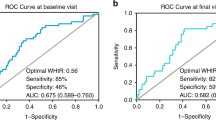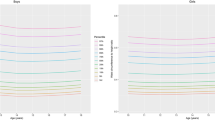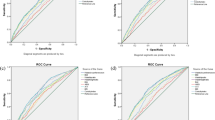Abstract
Objective: To develop age- and sex-specific waist circumference reference data for Canadian youth.
Design: Cross-sectional population survey.
Setting: 1981 Canada Fitness Survey.
Subjects: Nationally representative sample of 3064 youth (1540 boys and 1524 girls) 11–18 y of age.
Interventions: Waist circumference was measured with a flexible anthropometric tape.
Main outcome measures: Smoothed and weighted 5th, 10th, 25th, 50th, 75th, 90th, and 95th waist circumference percentiles derived from LMS regression.
Results: Waist circumference increases with age in both boys and girls, and boys have higher values of waist circumference than girls at every age and percentile level.
Conclusions: These reference data can be used to identify youth with an elevated risk of developing obesity-related disorders and can serve as a baseline for future studies of temporal trends in waist circumference.
Sponsorship: This research was funded by the Heart and Stroke Foundation of Ontario (Grant #T4946).
This is a preview of subscription content, access via your institution
Access options
Subscribe to this journal
Receive 12 print issues and online access
$259.00 per year
only $21.58 per issue
Buy this article
- Purchase on Springer Link
- Instant access to full article PDF
Prices may be subject to local taxes which are calculated during checkout


Similar content being viewed by others

References
Bellizzi MC & Dietz WH (1999): Workshop on childhood obesity: summary of the discussion. Am. J. Clin. Nutr. 70, 173s–1175s.
Chan JM, Rimm EB, Colditz GA, Stampfer MJ & Willett WC (1994): Obesity, fat distribution, and weight gain as risk factors for clinical diabetes in men. Diabetes Care 17, 961–969.
Cole TJ, Bellizzi MC, Flegal KM & Dietz WH (2000): Establishing a standard definition for child overweight and obesity worldwide: international survey. BMJ 320, 1240–1243.
Cole TJ, Freeman JV & Preece MA (1990): British 1990 growth reference centiles for weight, height, body mass index and head circumference fitted by maximum penalized likelihood. Stat. Med. 17, 407–429.
Cole TJ & Green PJ (1992): Smoothing reference centile curves: The LMS method and penalized likelihood. Stat. Med. 11, 1305–1319.
Fitness Canada (1981): Standardized Test of Fitness: Operations Manual. 2nd edition. Ottawa, ON: Ministry of Fitness and Amateur Sport.
Fitness Canada (1983): Fitness and Lifestyle in Canada. Ottawa: Government of Canada.
Flodmark CE, Sveger T & Nilsson-Ehle P (1994): Waist measurement correlates to a potentially atherogenic lipoprotein profile in obese 12–14-year-old children. Acta. Paediatr. 83, 941–945.
Folsom AR, Kaye SA, Sellers TA, Hong CP, Cerhan JR, Potter JD & Prineas RJ (1993): Body fat distribution and 5-year risk of death in older women. JAMA 269, 483–487.
Folsom AR, Kushi LH, Anderson KE, Mink PJ, Olson JE, Hong C-P, Sellers TA, Lazovich D & Prineas RJ (2000): Associations of general and abdominal obesity with multiple health outcomes in older women: The Iowa Women's Health Study. Arch. Intern. Med. 160, 2117–2128.
Freedman D, Dietz WH, Srinivasan SR & Berenson G (1999a): The relation of overweight to cardiovascular risk factors among children and adolescents: The Bogalusa Heart Study. Pediatrics 103, 1175–1182.
Freedman DS, Serdula MK, Srinivasan SR & Berenson GS (1999b): Relation of circumferences and skinfold thicknesses to lipid and insulin concentrations in children and adolescents: the Bogalusa Heart Study. Am. J. Clin. Nutr. 69, 308–317.
Katzmarzyk PT, Tremblay A, Perusse L, Despres JP & Bouchard C (2003): The utility of the international child and adolescent overweight guidelines for predicting coronary heart disease risk factors. J. Clin. Epidemiol. 56, 456–462.
Maffeis C, Pietrobelli A, Grezzani A, Provera S & Tato L (2001): Waist circumference and cardiovascular risk factors in prepubertal children. Obes. Res. 9, 179–187.
Martinez E, M D, Bacallao J & Amador M (1994): Percentiles of the waist-hip ratio in Cuban scholars aged 4.5 to 20.5 years. Int. J. Obes. Relat. Metab. Disord. 18, 557–560.
McCarthy HD, Ellis SM & Cole TJ (2003): Central overweight and obesity in British youth aged 11–16 y: Cross sectional surveys of waist circumference. BMJ 326, 624.
McCarthy HD, Jarrett KV & Crawley HF (2001): The development of waist circumference percentiles in British children aged 5.0–16.9 y. Eur. J. Clin. Nutr. 55, 902–907.
Moreno LA, Fleta J, Mur L, Rodriquez G, Sarria A & Bueno M (1999): Waist circumference values in Spanish children–gender related differences. Eur. J. Clin. Nutr. 53, 429–433.
Moreno LA, Pineda I, Rodriguez G, Fleta J, Sarria A & Bueno M (2002): Waist circumference for the screening of the metabolic syndrome in children. Acta Paediatr. 91, 1307–1312.
Must A, Jacques PF, Dallal GE, Bajema CJ & Dietz WH (1992): Long-term morbidity and mortality of overweight adolescents. A follow- up of the Harvard Growth Study of 1922 to 1935. N. Engl. J. Med. 327, 1350–1355.
NIH (1998): Clinical guidelines on the identification, evaluation, and treatment of overweight and obesity in adults—The evidence report. Obes. Res. 6 (Suppl2), 51S–209S: [published erratum appears in Obes Res 1998; 6, 464].
Pouliot MC, Despres JP, Lemieux S, Moorjani S, Bouchard C, Tremblay A, Nadeau A & Lupien PJ (1994): Waist circumference and abdominal sagittal diameter: best simple anthropometric indexes of abdominal visceral adipose tissue accumulation and related cardiovascular risk in men and women. Am. J. Cardiol. 73, 460–468.
Rankinen T, Kim SY, Perusse L, Despres JP & Bouchard C (1999): The prediction of abdominal visceral fat level from body composition and anthropometry: ROC analysis. Int. J. Obes. Relat. Metab. Disord. 23, 801–809.
Rexrode KM, Buring JE & Manson JE (2001): Abdominal and total adiposity and risk of coronary heart disease in men. Int. J. Obes. Relat. Metab. Disord. 25, 1047–1056.
Savva SC, Tornaritis M, Savva ME, Kourides Y, Panagi A, Silikiotou N, Georgiou C & Kafatos A (2000): Waist circumference and waist-to-height ratio are better predictors of cardiovascular disease risk factors in children than body mass index. Int. J. Obes. Relat. Metab. Disord. 24, 1453–1458.
Shephard RJ (1984): Fitness of a Nation: Lessons from the Canada Fitness Survey. New York: Karger.
Tremblay MS, Katzmarzyk PT & Willms JD (2002): Temporal trends in overweight and obesity in Canada, 1981–1996. Int. J. Obes. Relat. Metab. Disord. 26, 538–543.
Tremblay MS & Willms JD (2000): Secular trends in the body mass index of Canadian children. Can. Med. Assoc. J. 163, 1429–1433: [published erratum appears in Can. Med. Assoc. J. 164,970].
Wang J, Thornton JC, Bari S, Williamson B, Gallagher D, Heymsfield SB, Horlick M, Kotler D, Laferrere B, Mayer L, Pi-Sunyer FX & Pierson Jr RN (2003): Comparisons of waist circumferences measured at 4 sites. Am. J. Clin. Nutr. 77, 379–384.
Whitaker RC, Wright JA, Pepe MS, Seidel KD & Dietz WH (1997): Predicting obesity in young adulthood from childhood and parental obesity. N. Engl. J. Med. 337, 869–873.
World Health Organization (1998): Obesity: Preventing and Managing the Global Epidemic. Report of a WHO Consultation on Obesity, Geneva, 3–5 June. Geneva: World Health Organization.
Zannolli R & Morgese G (1996): Waist percentiles: a simple test for atherogenic disease? Acta Paediatr. 85, 1368–1369.
Acknowledgements
Special thanks to Tim J Cole of The Institute of Child Health, London, for providing the LMS program.
Author information
Authors and Affiliations
Corresponding author
Rights and permissions
About this article
Cite this article
Katzmarzyk, P. Waist circumference percentiles for Canadian youth 11–18 y of age. Eur J Clin Nutr 58, 1011–1015 (2004). https://doi.org/10.1038/sj.ejcn.1601924
Received:
Revised:
Accepted:
Published:
Issue Date:
DOI: https://doi.org/10.1038/sj.ejcn.1601924
Keywords
This article is cited by
-
Biomarkers of cardiometabolic complications in survivors of childhood acute lymphoblastic leukemia
Scientific Reports (2020)
-
A Bayesian multivariate latent t-regression model for assessing the association between corticosteroid and cranial radiation exposures and cardiometabolic complications in survivors of childhood acute lymphoblastic leukemia: a PETALE study
BMC Medical Research Methodology (2019)
-
Cardiometabolic Risk Factors in Childhood, Adolescent and Young Adult Survivors of Acute Lymphoblastic Leukemia – A Petale Cohort
Scientific Reports (2017)
-
Comparison of anthropometric measurements in children to predict metabolic syndrome in adolescence: analysis of prospective cohort data
International Journal of Obesity (2015)
-
LMS tables for waist-circumference and waist-height ratio Z-scores in children aged 5–19 y in NHANES III: association with cardio-metabolic risks
Pediatric Research (2015)


